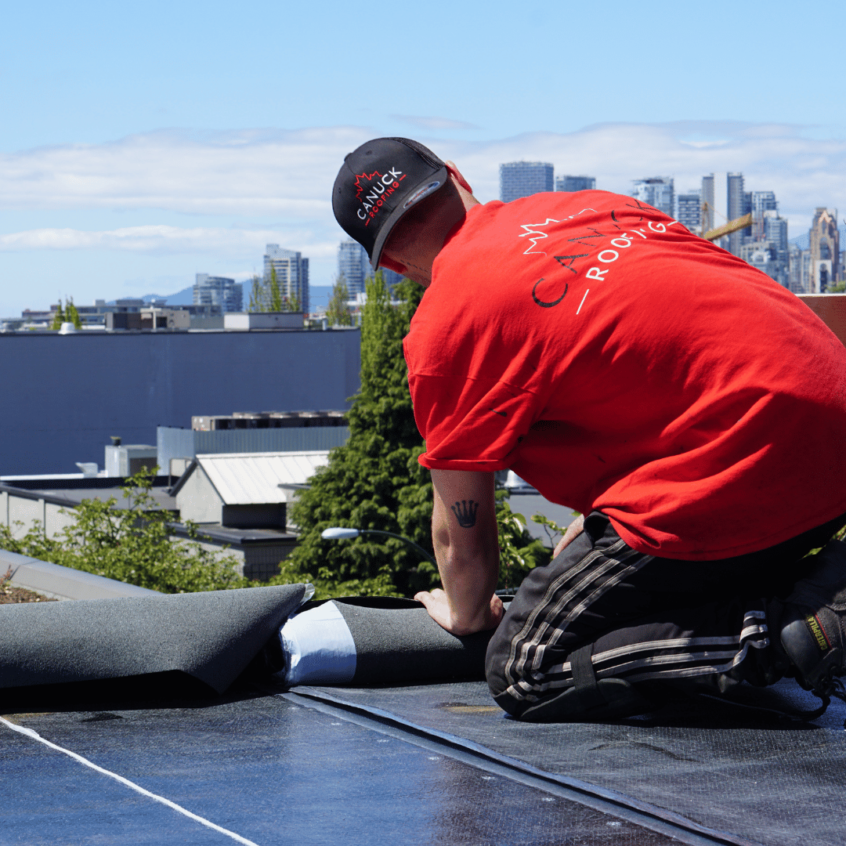Yes, and a well-maintained flat roof can last 20 or even 30 years! This kind of roofing is cost-effective, modern, high quality, and very durable. However, it can be more challenging to waterproof compared to pitched roofs. That’s okay! There are solutions available to support your flat-roof design, regardless of the climate.
This blog will discuss and provide tips on how to waterproof your flat roof using different types of materials like liquid waterproofing, reinforced bitumen membrane, thermoplastic polyolefin roofing membrane, and asphaltic single-ply membrane. If you’re looking to insulate your flat-roofed home or commercial building from the elements, you’ve come to the right place.
Liquid Waterproofing
This is a liquid coat that, when dry, helps protect your roof from the elements. It’s made of either fibreglass liquid or glass-reinforced plastic. Not only is this type of waterproofing useful for flat roofs, but also slate roofing and aluminum roofing. If applied correctly, this type of waterproofing can last anywhere between 20-40 years, making sure your house stays insulated from the elements for a long time! Of course, this is always dependent on the application, quality of product, and maintenance after installation.
This type of waterproofing is the easiest to apply, but we still recommend hiring a roofer for the application. Incorrect application might mean a lack of waterproofing, which can lead to a disastrous impact on your home long-term. Be proactive and have it done right the first time to prevent any longterm damage.
Reinforced Bitumen Membranes
Bitumen membranes can be extremely waterproof when two to three layers are laid on your flat roof. Hot bitumen bonds the layers and a polyester carrier combines them. If you’re looking for a warm flat roof, it is laid across the insulation. If you’re seeking a cold flat roof, it’s placed across the structural deck. Some methods for application include self-adhesive, torching, and cold application—although these are all most effective when applied by a professional!
Single Ply Membrane
If you’re looking to waterproof a large, flat-roofed structure, single ply membrane is the way to do it. Each single ply membrane sheets measures between 1-2mm wide, 1-2mm thick, and 30m long. These sheets perform best when coupled with warm flat roofs on top of the insulation. An extra layer of protection should be applied also under the insulation and on the structural deck for peak performance. Methods of application for single ply membranes include, but are not limited to: fastening, adhesion, and ballasting.
TPO (Thermoplastic Polyolefin) Roofing Membrane
A single-ply white plastic membrane commonly used on domestic properties to waterproof. Because of its colour, this type of waterproofing method is best used on a cold roof, not a warm one. Often, we see them on garages, covered patios, or sheds.
The only downside to TPO is that it might end up looking dirty over time due to its colour. If looks are important, we don’t recommend a TPO membrane. However, if the roof won’t be visible or how it looks doesn’t matter as much, then this is an excellent solution to the rainy BC weather!
Conclusion
When water and debris collect on a flat roof, the pooling can rot away at what’s underneath and cause mold, leaks, and structural problems. Choosing to waterproof your flat roof is very important, and the way in which is done even more so! If you’re looking to have your flat roof waterproofed or assistance in doing so, contact Canuck Roofing for a quote. We’re always happy to help! You don’t need a sloping roof to live in the Pacific North West, just a good team of roofers to support your design.

